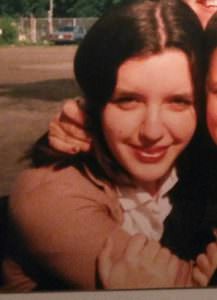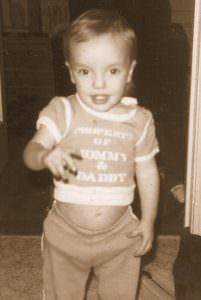I’ve lived with Borderline Personality Disorder for years. Why I’m finally talking about my diagnosis
Erica Ruth Kelly was diagnosed in her teens, but stigma has kept her quiet—even amid calls for more acceptance of mental health challenges
Erica Ruth Kelly

Current photo of the author.
Trigger warning: self-injury, suicide
When I was 18, a psychiatrist kicked me out of her office in my hometown of Montreal. A framed Sigmund Freud witnessed my humiliation. I’d raised my voice, confessing that I’d scratched up my arm again because I was “fucking sad.” My psychiatrist told me to go to the hospital. She couldn’t help me, she said.
I wondered if she knew how helpless I already felt during our sessions. I wondered if she noticed how the frenetic sound of her keystrokes made me tense, or how I would hold my breath when she’d interrupt the logging of my despair into her laptop to look me in the eye. Would she again suggest that I was lazy? Could she tell my pupils dilated whenever we discussed my medication? I knew that she couldn’t help. What I didn’t know was that I had Borderline Personality Disorder (BPD) and for the next 17 years, help would be hard to find.
If you read an article on BPD, you’ll likely see the criteria listed in the Diagnostic and Statistical Manual of Mental Disorders 5 (DSM-5), the standard classification system of mental disorders used by mental health professionals in North America. These criteria can tell you that a person with BPD likely has significant impairments in personality and interpersonal functioning, such as unstable self-image often associated with self-criticism. That doesn’t explain what it’s like to spend most waking hours feeling hollow. The DSM-5 describes pathological personality traits, such as anxiousness, separation insecurity, and depressivity. That doesn’t tell you what it’s like to think you might lose your mind because someone you care about is an hour late. The DSM-5 lists impulsivity, citing “self-harming behaviours under emotional distress,” as well as hostility, manifested as “anger in response to minor slights and insults.” That doesn’t illustrate that despite improvements, BPD remains one of the most highly stigmatized diagnoses.
The professional stigma against BPD is only worsened by the performative one. Two percent of the North American population suffers from BPD. Yet mainstream representations of BPD consistently use the same characters bending to the same arc—a white, cisgender, heterosexual woman (think Girl, Interrupted; Welcome to Me) who has often been spurned by a male lover with whom she becomes violently obsessed (Fatal Attraction; Malicious; Play Misty for Me).
Through this lens, we only see BPD sufferers on their worst day. Context and history seem less important than presenting audiences with the hysterical woman, perhaps because it’s easier than trying to understand the complexities of the disorder. But these representations negate the individual narratives of those with BPD and reinforce the stigma. The stigma reinforces silence. The silence reinforces stigma.
I’ve been contributing to this cycle for nearly half my life. I have never publicly disclosed my BPD diagnosis until now, because I’ve finally realized that not saying something says something.
***
The reality of living with BPD is as unique as the person experiencing it. For me, it means a heartless voice in my head that screams You’re worthless. Sometimes the voice gets quieter, but it’s always here, buzzing in the background like white noise. BPD means being scared easily and often—frightened that I’m one panic attack away from losing a job or losing a writing client, or that something someone says or does, or that I see in real life or on TV, will trigger a downward spiral. (One time I couldn’t leave my bed for four days after binge watching the first season of True Detective.) I know others who have BPD. They hear the white noise voice, too—one that tells them they are fundamentally unlovable. They try to cope by using drugs, alcohol, food, sex, self-harm—anything, as long as it numbs.
We also contend with real voices of health care practitioners. One doctor told my friend with BPD that “everyone feels sad sometimes.” Another told a friend they would have to attempt suicide to receive in any help.
“‘Borderline’ has become almost pejorative in the healthcare system,” says Dr. Jonathan Petraglia, a licensed psychologist in private practice in Montreal, lecturer at McGill University, and my former classmate in high school. In Grade 11, Petraglia’s locker was right next to mine. We would see each other in the morning, though I don’t know if he ever noticed how tired my eyes always looked. After I emailed him about interviewing him for this piece, he became the first person from high school to know about my diagnosis.

The author as a teen.
While I’ve often thought my symptoms started to emerge when I was about 14, Petraglia tells me it’s not possible to diagnose BPD in children or adolescents. Warning signs in children include frequent crying, hypersensitivity to interpersonal information, and separation anxiety. (At 9, I missed my mom so much at sleep-away camp that I cried until I nearly vomited.) But these signs are not uncommon in many children. Research indicates that it’s a matter of degree, which can be difficult for a parent to assess.
The same can be said for warning signs in teenagers, since the criteria describes what a lot of people go through in adolescence, Petraglia explains. A good example of this is identity diffusion, characterized by a “deep sense of emptiness, of disconnect from people, of feeling unloved, of not understanding who they are, what defines them.” It’s why many teenagers hear: “You’re going through a phase.”
For a long time, my mother had come to this same conclusion. Recognizing the duration and consistency of this phase, and the distress and decrease in functioning it causes, can be difficult. As an adolescent, I was brooding. I worried a lot, listened to a lot of Tori Amos, and wrote tortured poetry. Then, I started cutting or scratching myself, sometimes more than once a day. I thought about death. I hid those things from my mom, from everyone. I dropped out of CEGEP, my pre-university program, with only one semester until graduation. I couldn’t study. I couldn’t work. I couldn’t do anything but make macaroni and cheese and smoke cigarettes. I put on 50 pounds in six months.
“You always seemed like you were okay,” my mom would tell me a decade after that first major depressive episode. By my late teens, I knew I wasn’t. I was sure I was a terrible person. The nurse who assessed me after a cry-for-help overdose said it was my fault. I thought she was right. I thought I couldn’t get better. Following a devastating break up, at 19, I tried to kill myself. Up to 10 percent of individuals with BPD will die this way.

The author as a child.
Following the suicide attempt, my mom confided her concerns about me in a cousin. He gave her the phone number of a psychologist, a friend of his. My mom met with him once, told him my symptoms. He told her it sounded like I had BPD. I read up on it: Yes. That was me. I began looking for help. Unfortunately, in Quebec, programs for treating BPD are not the “all-encompassing type of program you would need to treat personality disorders in a very effective way,” Petraglia says. Instead, small treatment programs are offered at a number of clinics and hospitals; but they are not intensive.
I never knew such programs existed, but I did try everything else I could. For five years, I experimented with different medications, self-help books, modalities, psychiatrists, and therapists. One of the most marking experiences was the work I did with Lindsay Chipman, a licensed psychotherapist I saw from 2005 to 2009. Throughout that time, we never specifically discussed BPD. “Back then, I wasn’t interested in relating to you as BPD,” Chipman says. “I really just wanted to get to know you. And I think that’s really important when working with any patient. We’re not relating to the diagnosis,” which, she explains, doesn’t speak to any of the underlying dynamics that are creating any of the symptoms.
She’s not the first person to tell me this. A therapist to whom I’d disclosed my BPD diagnosis also didn’t want to focus on it, fearing the label might impede my progress in therapy. Some people with BPD find the label helpful; it helps them understand themselves better. Others find it forces them to pathologize what is actually very normal, human behaviour.
Chipman says BPD traits exist along a spectrum. She refers to the DSM-5’s list of criteria for the disorder, which she prefers to call a “character structure,” as “everything and the kitchen sink. You could fit many people into that category.” For instance, one of the most common traits of an individual with BPD is black-and-white thinking, or “splitting,” where we categorize things as all good or all bad. “We all do that,” Chipman says.
It’s also helpful to remember that at some point, the pathological behaviours that comprise this cluster called BPD “were absolutely necessary for (patients with BPD) to have their needs met…It’s just that their adaptiveness has expired.”
Chipman treated me until I came off my medications, Effexor and Seroquel, at the beginning of 2009. From 2009 to 2013, I was more functional than I’d been in years. I still occasionally had panic attacks, but I blamed it on graduate school, where I was studying English literature. I medicated with a more socially sanctioned method of self-harm: excessive alcohol. I thought I was fine.
***
Following a move from Montreal to Toronto in 2013, my symptoms re-emerged with a vengeance. I was in denial about it. Then, in November 2015, I had a dissociative episode. I dropped off my dog at a groomer, but something was off. As I walked, the sidewalk felt as though it was pulling me in, like the concrete was quicksand. About 72 hours later, I felt it again: I fell to my bedroom floor shaking and crying. I was convinced that if I left my spot, I would die.
I was too scared to tell anyone what had happened. It was too humiliating. I was a grown-up. I should be over BPD, I thought. What would people think if they found out? What would my family say if they knew I was self-injuring again? Would I be considered a lost cause? What would my friends do? Would they Google it and decide to never speak to me again? How could my doctor help? Would I get moved around the system in Ontario, the same way I was in Quebec, the same way one of my friends with BPD got misdiagnosed and tossed around in Manitoba?
Sobbing, I finally called a friend. Whether this was BPD or not, it was not a phase. It was not going anywhere unless I forced it to.
My friend recommended I look into the services offered by the Centre for Addiction and Mental Health (CAMH). I learned about its Borderline Personality Disorder clinic. For a year beginning in January 2016, I was part of an outpatient research study, where I received Dialectical Behaviour Therapy (DBT). Designed by Dr. Marsha Linehan, psychologist, author, and professor at the University of Washington, DBT is widely considered the gold standard for treating BPD. It involves seeing an individual therapist for one hour per week and group therapy for two hours per week. DBT was originally developed to treat suicidal behaviours, but was subsequently expanded to treat BPD and other complex mental disorders that involve serious emotion dysregulation. This treatment was easily the most emotionally brutal and effective therapy I’ve ever received.
During each individual therapy session, I would present my therapist with a diary card on which I’d tracked my daily fluctuation of emotions, my urges to resort to maladaptive behaviours, and whether or not I’d engaged in them. I had to assign a number to the strength of these urges, zero being lowest and five being highest. If it sounds tedious, that’s because it is.
In group therapy, I learned skills from four different modules: interpersonal effectiveness, distress tolerance/reality acceptance, emotional regulation, and mindfulness skills. Every week, group members shared how they practiced the skill we learned the previous week. We often cried together, but it wasn’t confrontational or confessional in the way I’d imagined. Instead, it was a compassionate support system, vital to my recovery.
One week, one of the group members coming off of medication started to cry. I started to cry, too. I was empathetic: Withdrawal makes everything too loud, too manic, too much. I told her she was doing much better than she realized; the fact that she was in group that day was proof. She smiled and thanked me—and I wondered if perhaps this pain can be used for good.
Dr. Carmen Wiebe, one of my group facilitators, has been working at the BPD clinic since 2002. After I completed the program, I asked her if moving to a new city would have been enough to trigger someone’s symptoms. “Moving is definitely one of life’s big stressors, so it certainly makes sense,” she tells me, though it’s not as clear-cut as that. It also depends on what the stressor represents and whether it overlaps with previous triggers.
“BPD tends to be a waxing and waning disorder,” Wiebe explains. “The symptoms intensify and de-intensity over time.” It’s true. Sometimes BPD feels like an ever-looming spectre.
When I ask if these symptoms will ever go away, Wiebe says it’s complicated. “It depends on which symptom,” she responds. “The behavioural symptoms like self-harm and anger outbursts and other impulsive behaviours can go away completely.” Having emotions that are easily prompted and take awhile to resolve can also go away, or at least become more manageable over time.
That said, the outcome of treatment varies greatly depending on the individual. And access to treatment is unfortunately less than ideal. Given the prevalence of BPD and that CAMH’s clinic is “kind of tiny compared to a lot of other services… we are completely unable to meet the demand.”
CAMH’s BPD clinic treats approximately 280 patients per year. These patients included my fellow group members, Chantel, 33, and Elliott, 23, to whom I grew close. I heard my story in theirs. Misdiagnoses, getting tossed around the system, wrong medication, invalidation. “I’ve always been told I’m broken, or sensitive, or wired wrong, that I’m dramatic or crazy, untrustworthy, because I’m ‘classic Borderline’,” says Chantel. After suicide attempts brought them to CAMH’s emergency room, Elliott and Chantel both entered the DBT program.
While we began treatment at different times, the first few months were challenging for all of us. “I had a lot of issues at first,” Elliott, who identifies as non-binary and uses the pronoun they, recounts, “especially concerning the fact that I was one of the few people of colour, and I felt very surrounded by white folks… it was very hard to open up and connect.” Chantel tells me that she’d struggled to get into the program for a year, during which time her then-girlfriend had become her caretaker. At the beginning, the program was “a band aid covering up too big a scar.” Her partner left her a month or two into Chantel’s therapy.
Things evolved for all of us, though. The “seemingly very easy skills” took some getting used to, but they eventually helped Elliott manage their emotions and symptoms “far more effectively.” Moreover, “the group started to become a place where I knew everyone understood what I was feeling,” they tell me. For Chantel, it was a matter of adjusting her focus inward. “It’s taken me a long time to do the program for me,” she says. “I can still be willful as fuck, but I can see myself trying… not to save a relationship, or convince my parents I’m not going to attempt to kill myself. For me.”
After my graduation in early January, I admittedly felt lost without my therapist, my group, my facilitators. I had moments of dark, troubling thoughts. I was surprised to find out that even though I’d finished my program less than two weeks prior, the most the clinic could offer me by way of support were recommendations to other services. I could not receive any more coaching.
I understood the possible rationale. Other people need help. The clinic needs to minimize therapist burnout. I was also angry and sad about it.
Then a funny thing happened. I noticed that I wasn’t hiding. I was reaching out to friends for help. I noticed that for the most part, I didn’t have any strong urges to self-harm, self-medicate, dissociate, or avoid my life. I noticed that somewhere in this 17-year tangle of trying to become a better person for others, I’d decided to start living.
For me.
Erica Ruth Kelly is a Montreal-born writer, now based out of Toronto. Her essays, interviews, and reviews have been featured in an eclectic mix of publications, including the Globe and Mail, Montreal Gazette, Maisonneuve, The Toast, BuzzFeed, She Does the City, The Puritan, Four Minutes to Midnight, and others.